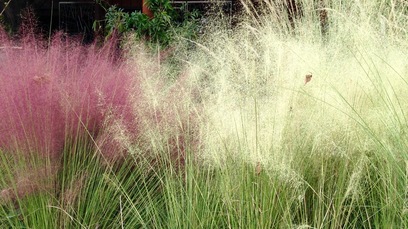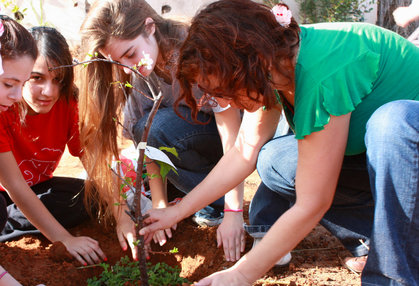
tel: 512 280-1192 thursday, november 12, 2015
Nursery Notes: onion sets arrived this week! White Bermuda,
red, super-sweet 10-15 all in stock: 1 bunch - $4. 2 bunches $7.
3 bunches $9. (There 20 - 13 per bunch.) Introduce some winter
colors into your landscape with snapdragons and pansies: six-
packs (jumbo) $4.99. Fruit trees are in stock: apples, peaches,
pears, and plums: 5 gal. trees for $34.99. Lots of oaks in stock:
red oaks, Monterrey oaks, live oaks, burr and chinquapin oaks.
5 gal - $35, 15 gal $125, 30 gal $250.

Muhley grass. . . 'sways gently with every sigh of a breeze. . . '
This stand of pink & white gulf muhly was spotted at the charm-
ing Texas French Bread bistro/café in UT's west campus earlier
this week. Muhlenbergia cappilaris flourishes in full sun, and
is drought-tolerant once established. (We have 1 gal. pots of
of pink Muhley for $7.99.)
___________________________________________________
41 Gorgeous Garden Paths: the recent rains have created a
quagmire in some yards - especially when dogs and hens are in
the picture. If you're thinking about a pathway, we can guarantee
inspiration from this selection of images by Sunset Magazine
___________________________________________________
Pistou - an alternative to pesto. With the first frost of the win-
ter possibly expected just 16 days from now (Nov 28) thoughts
of some are turning to what to do with a crop of basil. Many of
us have created pesto - but another use to consider is this French
addition to soup called Pistou: Food & Wine
____________________________________________________
Central Texas Gardener: Annuals warm up winter for salads &
wildlife. See a garden that directs and retains rainfall runoff. On
Sat. 4 p.m., Sun. at 9 a.m. KLRU

How to Plant a New Tree
by Amanda Moon
Fall and winter are the perfect times to plant trees in Texas. Our soil
does not freeze and our temps don’t often fall below 15 degrees
Fahrenheit, which makes it easier to transplant than any other time
of the year.
In addition, cooler temperatures allow us to get away with less water-
ing after planting and a longer period of establishment before the
hot temperatures head our way again. Larger shade trees, i.e. oaks
and elms, are especially grateful for an earlier planting date.
Another benefit is that there's less transplant stress on a tree that's
dormant. Even evergreens tend to take a top growth 'break' during
the winter. To make sure that you have a healthy tree even when
it has lost all its leaves, scratch the end of a few branches through
the bark with your fingernail. If you see green, the tree is still alive
to the tips of the branches – a very good sign of viability.
____________________________________________________
Ten Tricks of the Trade
1. Choose the right location. Leave enough space for your tree to
grow and stay clear of power lines above and below the ground
(call 1-800-DIG-TESS if you aren’t sure of utilities).
____________________________________________________
2. Double check your soil type against the tree you want to plant.
A pecan, for example, will struggle if planted in very shallow soil.
____________________________________________________
3. Make sure that you start with a healthy specimen from a reput-
able source. Most local nurseries buy their stock from local growers
and so the tree is already adjusted to our climate.
____________________________________________________
4. Dig an irregular hole. Tree roots can be lazy and a perfectly
round hole can trick a tree into believing it is still in the pot and it
may fail to grow roots outwards.
____________________________________________________
5. Be sure to make the hole a few inches shallower than the root
ball of the tree. Use the length of a shovel to measure. In time the
tree will settle in flat.
____________________________________________________
6. When you remove the pot, if the tree doesn't come out easily
roll the pot sideways on the ground to loosen or cut away if necess-
ary. Do not put unneeded pressure on the trunk of the tree.
____________________________________________________
7. Water as you fill in to eliminate air pockets in the soil.
____________________________________________________
8. Use a mix of native soil and a compost or soil blend made for
tree planting.
____________________________________________________
9. Only cover the root ball a few inches and don’t pile up soil or
mulch around the trunk (ever!). Create a donut-style ring around
the outside root-ball area of the tree for a water basin, using extra
soil to build it. Top dress with mulch to preserve soil moisture.
____________________________________________________
10. Water in again one final time into the center of the ring using
a root stimulator such as SuperThrive to encourage quicker rooting.
_____
Make sure after your new tree is planted that you water deeply at
least once a week. (Increase watering the later into the hotter months
you plant.) Don’t stake the tree unless you are planting in a windy
location. Un-staked trees are stronger and at maturity are better at
withstanding windstorms.
Avoid using chemical fertilizers on trees, especially during their
first three seasons. This is the amount of time it takes for a tree to
become fully established, and the roots are especially sensitive
during this time.
Apply compost and organic root stimulators. After they're estab-
lished, use an organic fertilizer during the growing season.
Continue watering as needed to keep the tree healthy. A drought-
stressed tree cannot always revive itself to its’ former glory when
the rains come again.
Lastly, a few specifics for those special situations. Our soil is tough
to dig through sometimes. If you can’t go down more than a few
inches, create a large raised bed with all those extra boulders lying
around and plant up. Make sure you give the tree a decent width
and height to the bed based on the final size of the chosen species.
Along those same lines, whoever said that a tree hole must be twice
as wide as the pot clearly had never tried digging in our soil. Be
sure to make it wide enough so that once the tree is in the ground
you can get your arm down around it to push the soil fully down.
Otherwise, I (and the tree) forgive you if it isn’t any bigger than
that. Happy Gardening everyone!


Please contact newsletter editor Darrel Mayers (pictured above)
with any ideas for articles or interesting links:
internationalrain@yahoo.com (hitting 'reply' to this email won't work) )
Visit the website: Its About Thyme facebook
Visit the nursery: 11726 Manchaca Road, Austin, 78748